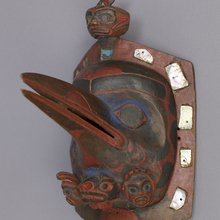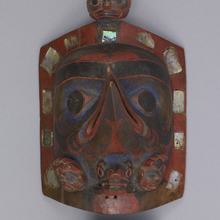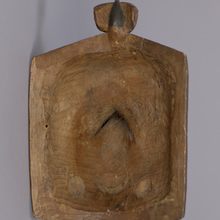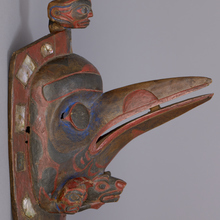Frontlet
MOA: University of British Columbia
3260/58
Carved and painted hardwood frontlet with abalone inlays around the sides and top. Main image is a raven with a large bird beak projecting outward. A small, three-dimensional whale sits at the top of the frontlet. Three small faces are carved along the bottom: a grizzly bear or wolf head is in the centre, with human-like faces at each side.
-
Narrative
Carved frontlets are a form of chiefly regalia that, with the associated dancing, originated on the northern coast and travelled south through dowry and other exchanges. Moreover, from the early 1800s and perhaps before, the practice of carving and using such regalia was adopted and reimagined by artists from the Tlingit in the north to the Nuu-chah-nulth in the south. On the central coast of what is now British Columbia, carvers of the Heiltsuk, Nuxalk, Haisla, and Kwakwaka’wakw created frontlets of distinctive visual power. Characteristics of this frontlet that reveal its central-coast origins include the depth and shape of the raven’s eye orb, the shape of the rim, the form of the whale figure on top, and the features of the faces in the paws of the wolf or grizzly-bear figure at the bottom. Comparing similar works with known provenance helps to support attributions, as will future comparative work on the pigments and other components of the paints used by artists of different areas.
-
Specific Techniques
Paint includes Reckitt’s Blue [synthetic ultramarine].
-
Iconographic Meaning
Human face on an animal carving indicates that the creature has the ability to transform back and forth to human form. Hands are more hand-like than claw-like, meaning that he's kind of in-between. People coveted dances that other people amongst their own Nation didn't have, so they'd marry or wage war to get it. The abalone represents when the daylight is breaking down, coming from the heavens, representing where these dances come from [Hiłamas, William Wasden, Jr. - ’Namgis (Kwakwaka’wakw), 2019].
- Type of Item frontlet
- Culture Heiltsuk
- Material wood, abalone shell, paint
- Measurements height 29.0 cm, width 18.0 cm, depth 21.0 cm (overall)
- Previous Owner Elspeth McConnell
- Received from Elspeth McConnell
- Made in British Columbia
- Collected in Bella Bella, 'Qvuqvai
- Creation Date between 1850 and 1880
- Ownership Date before August 12, 2017
- Acquisition Date on August 12, 2017
- Condition good
- Accession Number 3260/0058



